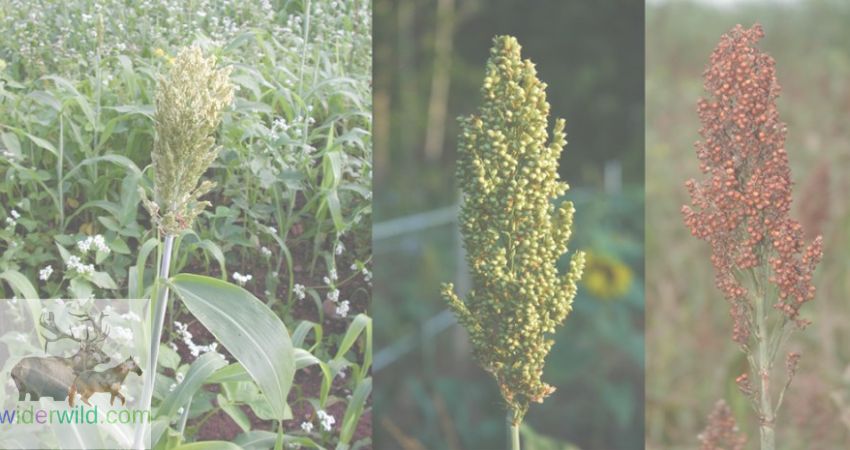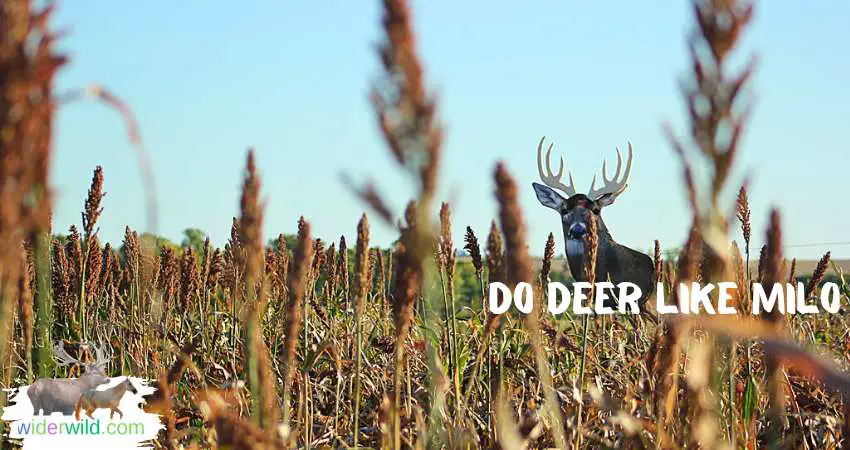Deer generally do not prefer Milo as a food source. However, other factors can influence their dietary preferences and behaviors.
Deer are herbivores, primarily feeding on grasses, leaves, and tender plant shoots. While there may be instances where deer consume some Milo, it is not their preferred food.
Deer are more likely to be attracted to crops such as corn, soybeans, and fresh vegetation found in fields and meadows.
Factors like availability of food sources, seasonality, and regional variations can also play a role in deer preferences for certain types of plants. These factors can help manage wildlife populations and prevent deer damage to crops and vegetation.
Deer’s Preference For Food
For those seeking to attract and marvel at the beauty of deer, understanding their culinary inclinations is paramount. Despite being herbivores, deer exhibit diverse diet preferences shaped by various factors. I will uncover the intriguing world of deer diets and unravel the influences that shape their culinary choices.
Different Diet Preferences Of Deer
Deer have a diverse palate when it comes to their food choices. While they primarily feed on plants, their preferences can vary depending on the season and availability of food sources.
Here are the main types of food that deer are known to consume:
| 1. Browse | Deer are particularly fond of browse, which refers to the tender shoots, twigs, and leaves of woody plants. They often target young trees, shrubs, and bushes. |
| 2. Forbs | Forbs are broad-leaved herbaceous plants that grow in meadows and open areas. Deer have a preference for certain forbs, such as clover, dandelion, and goldenrod. |
| 3. Grass | While deer are not commonly associated with eating grass, they do consume it, especially during the summer months when it is abundant. They feed on the more tender grass shoots. |
| 4. Fruits and Nuts | During the fall, deer seek out fruits and nuts as a vital source of nutrition. They have a particular affinity for acorns, apples, and berries. |
Factors That Influence Deer’s Food Choices
Several factors influence the food choices of deer. Understanding these factors can help you better cater to their preferences and attract them to your property.
Here are some key factors:
- Seasonal Availability: The availability of certain food sources varies with the seasons. Deer adapt their diet accordingly, focusing on what is most abundant during each season.
- Nutritional Value: Deer have a keen sense of detecting the nutritional value of food. They are more likely to consume plants that provide them with the necessary nutrients and energy.
- Taste and Palatability: Just like humans, deer have preferences when it comes to taste. They are more likely to feed on plants that are palatable and have favorable flavors.
- Habitat: The habitat and surroundings also play a significant role in deer’s food choices. They are more likely to consume plants that are readily available in their natural habitat.
- Competition: The presence of other herbivores can influence deer’s food choices. They may adjust their diet to avoid direct competition for food resources.
By understanding the different diet preferences of deer and the factors that influence their food choices, you can create an environment that attracts them and provides them with the nourishment they need.
Whether you are a wildlife enthusiast or a landowner looking to enhance the biodiversity of your property, catering to deer’s food preferences can be a rewarding endeavor.
The Taste Buds Of Deer
When it comes to attracting deer to your backyard, understanding their taste preferences is key. After all, knowing what flavors they enjoy can help you create a wildlife-friendly environment that they won’t be able to resist.
So, what exactly do deer find appetizing? Let’s delve into the world of deer taste buds and explore how they perceive different flavors.
The Sense Of Taste In Deer
Like humans and other animals, deer have taste buds that allow them to distinguish between different flavors and determine their palatability. These taste buds are located primarily on their tongues, allowing them to taste the food they consume.
How Deer Perceive Different Flavors
Deer have a unique set of taste preferences that help guide their foraging behaviors. While they are primarily herbivores, their taste buds are not as well-developed as those of humans. Unlike us, deer have fewer taste receptors, especially for sweet and savory flavors.
While deer are known to have a preference for certain flavors, such as fruits and young shoots, their taste perception differs from ours.
For example, they have a limited ability to taste sweetness, and what we might consider sweet, like Milo, may not elicit the same response in deer. Instead, they rely more on their sense of smell and the presence of certain compounds to determine the desirability of food.
When it comes to flavors that deer find unappealing, they tend to dislike bitter tastes. This aversion to bitterness serves as an evolutionary defense mechanism, making them less likely to consume potentially toxic plants or spoiled food.
Individual deer may have slight variations in their taste preferences, much like humans do. While some deer may enjoy the taste of Milo, others may not find it as enticing.
Ultimately, the presence of other food sources, availability of water, and local environmental factors also play a role in a deer’s dietary choices.
So, while Milo may not be their top choice on the menu, you can still attract deer by offering a variety of natural plants and nutritious browse that align with their taste preferences.
Analyzing The Nutritional Value Of Milo For Deer
Milo is a nutritious food source that deer find appealing due to its high nutritional value. It can be a great addition to their diet, providing them with essential nutrients to support their overall health and well-being.
Key Nutrients Found In Milo
Milo, also known as sorghum, is a widely cultivated cereal grain that can serve as a valuable food source for deer.
An essential evaluation of the key nutrients it provides, Milo is rich in several vital nutrients that contribute to a deer’s overall health and well-being.
Protein:
Deer require protein for muscle development, growth, and repair. Milo contains a moderate amount of protein, making it a valuable component of their diet.
This nutrient facilitates antler growth in bucks, ensuring their strength during the mating season and enhancing their overall survival.
Energy:
Milo serves as an excellent source of energy for deer. Its high carbohydrate content provides the necessary fuel for their daily activities, including searching for food, mating, and escaping predators.
With easy access to sufficient energy from milo, deer can maintain their physiological functions and withstand harsh environmental conditions.
Fiber:
Fiber is an essential component of a deer’s diet as it aids in digestion and promotes overall gastrointestinal health.
Milo is known for its fiber content, which helps deer maintain a healthy digestive system, ensuring effective absorption of nutrients from other food sources.
Comparison Of Milo With Other Common Deer Foods
To comprehend the nutritional value of milo for deer, it is helpful to compare it with other commonly consumed deer foods.
Let’s consider how Milo measures up to two popular options: corn and soybeans.
| Milo | Corn | Soybeans | |
|---|---|---|---|
| Protein | Contains a moderate amount | Higher protein content | Highest protein content |
| Energy | A good source | High energy content | Rich in energy |
| Fiber | Significant fiber content | Lower fiber content | Minimal fiber content |
Milo can be a beneficial addition to a deer’s diet due to its decent protein and energy levels, as well as its fiber content. However, if seeking to provide deer with a higher protein intake, corn and soybeans may be more suitable options.
A diverse diet comprising multiple food sources tends to offer the most balanced nutrition for deer.
Including milo in a deer’s diet can be a strategic choice, especially if other food sources are limited. Its combination of nutrients contributes to the overall well-being and resilience of deer, promoting healthy growth and development.
Whether you decide to feed deer milo or consider it as part of their natural diet, the key is to provide a varied selection of suitable foods to ensure they receive the necessary nutrients for optimal health.
Observations Of Deer’s Consumption Of Milo
Deer’s consumption of milo is observed and it appears that they do enjoy it as part of their diet. The milo attracts deer and is quickly consumed, making it an effective option for hunters and wildlife enthusiasts.
Instances Of Deer Consuming Milo
Deer are fascinating creatures that have a diverse diet, including a wide range of plants and crops. One such crop that often captures the attention of deer is milo, a type of sorghum crop.
Observations of deer’s consumption of milo have revealed interesting insights into their feeding habits and preferences.
Instances of deer consuming milo have been reported in various regions where the crop is grown.
Farmers and wildlife enthusiasts have witnessed deer grazing on milo fields, particularly during the fall and winter months when other food sources may be scarce. These sightings indicate that deer are not only attracted to milo but are also willing to consume it as part of their diet.
Factors That May Influence Deer’s Attraction To Milo
Milo’s attractiveness to deer can be influenced by several factors:
- Sweetness and palatability: Milo grains can have a sweet taste that may be appealing to deer. The sugar content and overall palatability of milo may make it a favorable choice for deer.
- Availability: When other food sources are scarce, deer may be more likely to turn to milo as a readily available and accessible food option.
- Dietary needs: Deer have specific nutritional requirements, and milo can provide some essential nutrients. If milo meets these dietary needs, deer may be drawn to consume it.
- Feeding competition: In areas with high deer populations, competition for food can be intense. If milo fields offer a plentiful food source, deer may be more attracted to them.
- Field location: The proximity of milo fields to deer habitats or migration routes can greatly influence the likelihood of deer consumption. Fields located in or near deer’s natural feeding areas are likely to attract deer.
Observations have shown that deer do indeed consume milo, and several factors can influence their attraction to this crop.
Farmers and enthusiasts can take these insights into account when managing deer populations or when considering the potential impact of milo cultivation on local wildlife.
Pros And Cons Of Feeding Milo To Deer
Feeding deer is a popular activity for wildlife enthusiasts, and many people wonder if they should include milo in a deer’s diet.
Milo, also known as grain sorghum, is a cereal grain that is often used as birdseed. While deer can consume milo and derive some benefits from it, there are also potential drawbacks to consider.
Benefits Of Including Milo In Deer’s Diet
Milo offers several advantages when included in a deer’s diet, making it an appealing option for many wildlife enthusiasts.
Here are some of the benefits:
- Milo is an excellent source of carbohydrates, which are essential for providing deer with the energy they need for growth, reproduction, and survival.
- As a grain, milo contains a decent amount of protein, which is crucial for muscle development and overall health in deer.
- Feeding milo can attract deer to specific areas, making it easier for wildlife enthusiasts to observe or hunt them.
- Milo is relatively inexpensive and readily available, making it a convenient option for supplemental feeding.
Incorporating milo into a deer’s diet can be a beneficial addition, but it’s important to be aware of the potential drawbacks as well.
Potential Drawbacks Of Feeding Milo To Deer

While feeding milo to deer has its advantages, there are a couple of potential drawbacks to consider:
- High amounts of milo in a deer’s diet can lead to nutritional imbalances. Milo lacks certain essential nutrients, such as calcium and vitamin D, which are important for the overall health and development of deer.
- Feeding milo alone may not provide a well-rounded diet for deer. It’s crucial to supplement their diet with other food sources, such as native vegetation, to ensure they receive a balanced nutrition.
Moderation is key when it comes to feeding milo to deer. Including it as part of a diversified diet can offer certain benefits, but relying solely on milo may have negative consequences for the deer’s health.
Therefore, it’s essential to strike a balance and provide a variety of food sources to support the overall well-being of the deer.
Best Practices For Providing Milo To Deer
When it comes to providing food for deer, milo can be a great option. Deer are known to be attracted to milo due to its high carbohydrate content and appealing taste. You are following best practices for providing milo to deer to maintain a balanced diet and promote their overall health.
Suitable Feeding Methods For Milo
There are several suitable feeding methods for offering milo to deer. These methods include:
- Scatter feeding: One common method is scatter feeding, where you simply sprinkle milo on the ground in small quantities. This mimics the natural feeding behavior of deer and allows them to forage and graze.
- Feeders: Another option is to use feeders specifically designed for deer. These feeders can be filled with milo and placed in areas where deer are commonly found. This method helps to reduce the risk of other wildlife or domestic animals accessing the food.
- Food plots: Additionally, you can plant milo as part of a food plot. Food plots provide a controlled and dedicated area for deer to feed. Planting milo in a food plot ensures a consistent food source for deer throughout the season.
Recommendations For Maintaining A Balanced Deer Diet
While milo can be a valuable food source for deer, it is crucial to maintain a balanced diet to meet their nutritional needs.
Here are some recommendations to consider:
- Supplement with other feed: It is important to supplement milo with other types of feed to ensure a well-rounded diet. This can include offering hay, corn, or other grain mixes. A varied diet will provide the necessary nutrients for deer.
- Provide mineral supplements: Deer requires essential minerals for optimal health. Consider providing mineral supplements specifically formulated for deer to ensure they are receiving proper nutrition.
- Monitor feeding areas: Regularly monitor feeding areas to ensure that adequate food is available and that other wildlife or domestic animals are not consuming all the milo. Deer may need additional food sources if competition is high.
Maintaining a balanced deer diet is essential for their overall well-being. By incorporating these recommendations into your milo feeding practices, you can help promote a healthy deer population in your area.
Frequently Asked Questions For Do Deer Like Milo?
Do Deer Eat Milo In Their Natural Habitat?
Yes, deer do eat milo in their natural habitat. It is one of their preferred food sources.
Is Milo A Nutritious Food For Deer?
Milo is a nutritious food for deer as it contains essential carbohydrates, proteins, and vitamins needed for their growth and energy.
How Does Milo Benefit Deer During Winter?
Milo provides deer with a high-energy food source during winter, helping them stay warm and maintain their body condition.
Can Milo Attract Deer To Your Property?
Yes, planting milo can attract deer to your property as it is a highly desirable food source for them, especially during certain seasons.
What Are Some Other Wildlife Species That Feed On Milo?
Aside from deer, other wildlife species like turkeys, pheasants, and ducks also feed on milo due to its nutritional value and availability.
Is It Legal To Feed Milo To Deer In Some States?
Laws regarding feeding milo to deer vary by state. It is important to check your local regulations to ensure compliance.
How Can I Plant Milo To Attract Deer To My Land?
To attract deer, plant milo in open areas with good sun exposure and adequate soil moisture. Follow recommended planting guidelines for best results.
Final Words
While deer have been known to eat a variety of plants and flowers, the preference for milo may vary among individual deer. Gardeners and homeowners need to be aware of this potential attraction and take preventive measures to protect their crops.
By implementing strategies such as fencing or planting deer-resistant plants, one can minimize the damage and maintain the beauty of their gardens.
Read Related Post on Deer Diet and Feeding Habits:

